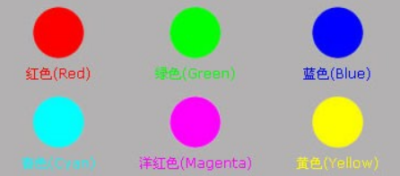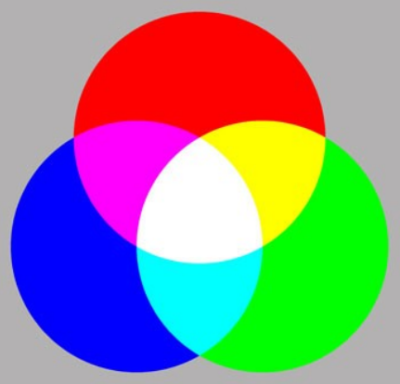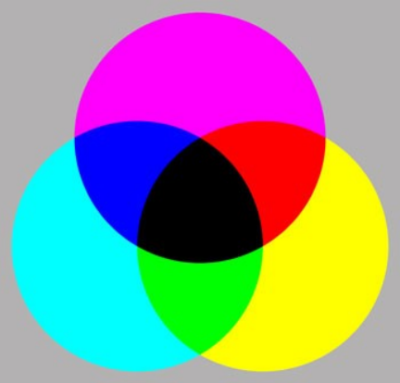The colorimeter and glossmeter developed and produced are optical testing instruments. The reason why these instruments can measure the color difference, gloss, chromaticity, and image clarity of various products is due to the optical principles of their internal design. Learning optical knowledge is very helpful for the use and analysis of color difference meters and glossmeters. People can see that color and light density are inseparable. Only in the visible spectrum can we clearly see color through the naked eye. Generally, the wavelength of visible light that the human eye can feel is 400 nm (purple) to 700 nm (red), and the visible spectrum is a small part of all electromagnetic spectrum.
There are thousands of colors in the world, among which red, green, and blue are known as the three primary colors. Changes in the ratio of red, green, and blue can produce multiple colors, and equal mixing of the three can reproduce white.
The concept of complementary color: The color formed by subtracting color X from white is called the complementary color of color X.
White red=cyan cyan
White Green=Magenta magenta
White blue=yellow yellow
White Red Green Blue=Black
Complementary color characteristics: When we use an X complementary color filter, we will find that the primary color corresponding to the complementary color will be filtered out.
Names of primary colors and corresponding complementary colors:

Name Of Primary Color And Complementary Color
There are two ways to achieve color reproduction:
Primary color addition: All three primary colors are added to form white, and any two primary colors are added to form complementary colors that do not participate in the synthesis.

Primary Color Addition
Subtraction of primary colors: All three complementary colors are added to form black, and any two complementary colors are added to form a primary color that does not participate in the synthesis.

Primary Color Subtraction
In these two methods, the addition of primary colors is relatively simple, which is the addition of other colors formed by the addition of primary colors. However, this method is rarely used in practical life; The primary color subtraction method is to subtract the corresponding primary color from white to form other colors, which is to use complementary colors to superimpose to form other colors. It is relatively common in applications.
We have introduced the knowledge of color above, but in fact, color definitions and concepts are not widely used in chromatic aberration meters, glossmeters, and other instruments. At most, they are optical concepts. Below, we will briefly explain optical knowledge.
The law of linear propagation of light: Light travels in a straight line in a uniform medium.
Fermat’s law is the first consideration in the development of glossimeters. The so-called Fermat’s law refers to the fact that when a beam of light propagates in vacuum or air, medium A transmits to the interface of medium B, it is generally divided into two types of light beams: reflection and refraction.
Reflection law: The reflection angle is equal to the incident angle, and i (reflection angle)=i ‘(incident angle).
The brightness of the mirror surface depends on the viewpoint, and the surface brightness varies with the viewing angle. This is why the current glossmeter is divided into 20 °, 60 °, 85 °, 120 °, and other angles.
In fact, the measurement principle of a glossmeter is an ideal diffuse surface that reflects incident light uniformly in all directions, and its brightness is independent of the viewpoint and is a constant.
Refraction law: n1 sin i=n2 sin r
The refractive index of any medium relative to vacuum is called the absolute refractive index of the medium, referred to as the Index of Refraction. In the formula, n1 and n2 represent the refractive indices of the two media, respectively.
The phenomenon of light refraction is caused by the different propagation speeds of light in different media. The refractive index depends on the properties of two different media and the wavelength of light.
The absolute refractive index of a medium in an ideal vacuum is: n=c/v (c is the speed of light in the vacuum, and v is the speed of light in the medium)
From the above formula, we can see that in a medium with a large refractive index, the speed of light is relatively low; In a medium with a small refractive index, the speed of light is relatively high.
Diffraction of light: During the propagation of light, when light encounters obstacles, it will deviate from the straight line, which is called diffraction of light. Due to the short wavelength of light, it is difficult to detect diffraction phenomena in daily life. Diffraction not only causes the geometric shadow of an object to lose its clear outline, but also produces a series of bright and dark lines at the edges.
Relatively complex optical knowledge is commonly used in our colorimeters. We all know that colorimeters are an optical color detection device developed using optical principles and color detection optics. This instrument has a very complex internal structure and is a precision instrument. There are many applications of optical theory. We can see these from “Analysis Principle of Chromatograph”.
When light rays parallel to the optical axis enter a convex lens, the ideal lens should be that all the light rays converge at a point and then spread out in a conical shape. This point where all the light rays converge is called the focal point.
Before and after the focal point, light begins to gather and diffuse, and the image of the point becomes blurred, forming an enlarged circle called a diffusion circle.
Different manufacturers and film areas have different numerical definitions of allowable circle of diffusion diameter.
The image perceived by the human eye is greatly related to magnification and viewing distance. The allowable dispersion circle for a 35mm photographic lens is about 1/1000 to 1/1500 of the diagonal length of the negative. The premise is that the image is enlarged to a 5×7 inch photo with a viewing distance of 25-30cm.
There is an allowable dispersion circle before and after the focal point, and the image blurring presented on the bottom surface is within the allowable range of the dispersion circle. The distance between these two diffusion circles is called depth of field, that is, the depth of field where the image still has a clear range before and after the subject (focus).
The depth of field varies with the focal length, aperture value, and shooting distance of the lens. For fixed focal lengths and shooting distances, the smaller the aperture used, the greater the depth of field.
Based on the camera holder, the distance from the focal point to the near allowable dispersion circle is called foreground depth, and the distance from the focal point to the far allowable dispersion circle is called back depth of field.
The larger the lens aperture, the smaller the depth of field; The longer the focal length of the lens, the smaller the depth of field; The shorter the focal length, the greater the depth of field; The closer the shooting distance, the smaller the depth of field. Compared to instruments with relatively complex internal results such as colorimeters and glossometers, it is relatively simple to use color light boxes and transmission light boxes. The main optical principles they apply are the color temperature, wavelength, and illuminance of light. Combining these factors, color comparison is performed.
Gloss meters AGM-580 are mainly used in the surface gloss measurement for paint, plastic, metal, ceramics, building materials. It conforms to the DIN67530, ISO2813, ASTM D523, JIS Z8741, BS 3900 Part D5, JJG696 standards and so on.
Portable Colorimeter/Chroma Meter is an innovation color measuring tool with powerful configuration to make color measurement easier and more professional; It support Bluetooth to connect with Android and ISO devices, Portable Colorimeter/Chroma Meter will take you into a new world of color management; It can be widely used to measure color value, color difference value and find similar color from color cards for printing industry, paint industry, textile industry, etc.
Tags:AGM-500PRO , AGM-580 , CD-320PROYour email address will not be published. Required fields are marked *